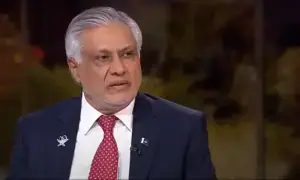SBP increases policy rate by 25 bps at 7.25 %
KARACHI: State Bank of Pakistan Monday increased its policy rate (interest) by 25 basic points at 7.25 percent as Monetary Policy Committee (MPC) noted that the pace of economic recovery has exceeded expectations.
At its meeting, MPC decided to raise the policy rate observing that since its last meeting in July 2021,this robust recovery in domestic demand coupled with higher international commodity prices is leading to a strong pick-up in imports and a rise in the current account deficit.
While year-on-year inflation has declined since June 2021 rising demand pressures together with higher imported inflation could begin to manifest in inflation readings later in the fiscal year.
With growing signs that the latest Covid wave in Pakistan remained contained, continued progress in vaccination, and overall deft management of the pandemic by the Government, the economic recovery now appears less vulnerable to pandemic-related uncertainty. As a result, at this more mature stage of the recovery, a greater emphasis is needed on ensuring the appropriate policy mix to protect the longevity of growth, keep inflation expectations anchored, and slow the growth in the current account deficit.
In line with this shift in the economic outlook, the MPC was of the view that the priority of monetary policy also needed to gradually pivot from catalyzing the recovery after the Covid shock toward sustaining it. As foreshadowed in previous monetary policy statements, the MPC noted that this rebalancing would be best achieved by gradually tapering the significant monetary stimulus provided over the last 18 months.
The MPC noted that over the last few months the burden of adjusting to the rising current account deficit had fallen primarily on the exchange rate and it was appropriate for other adjustment tools, including interest rates, to also play their due role.
The MPC noted that the stance of monetary policy is still appropriately supportive of growth, with real interest rates remaining negative on a forward-looking basis. Looking ahead, in the absence of unforeseen circumstances, the MPC expects monetary policy to remain accommodative in the near term, with possible further gradual tapering of stimulus to achieve mildly positive real interest rates over time.
The pace of this possible further gradual tapering would be informed by updated information on the continued strength of demand growth and the stance of fiscal policy, amongst other factors.
In reaching its decision, the MPC considered key trends and prospects in the real, external and fiscal sectors, and the resulting outlook for monetary conditions and inflation.
Real sector : With a supportive fiscal year 2021-22 budget and accommodative monetary policy, most high-frequency domestic demand indicators such as automobiles, POL (petroleum, oil and lubricants) sales, cement sales and electricity generation continue to depict robust growth. This growth is mirrored in the strength of imports and tax collections. LSM registered strong growth in June at 18.5 percent year-on-year before moderating in August to 2.2 percent year-on-year, in line with typical seasonal patterns.
The services sector was also rebounding strongly-- latest Google Community Mobility Reports show that activity across grocery stores, restaurants, and shopping centers during July and August rose above pre-Covid levels. In agriculture, the decline in the area under cultivation of cotton is expected to be compensated by an increase in area for rice, maize, and sugarcane. Based on these trends, growth in the fiscal year 2021-22 is now expected toward the upper end of the forecast range of 4-5 percent, notwithstanding some greater uncertainty with respect to spillovers from the evolving situation in Afghanistan.
External Sector : The current account deficit rose to $0.8 billion in July and $1.5 billion in August, reflecting both vigorous domestic demand and high global commodity prices. While remittances remained strong, growing by 10.4 percent (year-on-year) during July-August and exports also performed reasonably well (averaging $ 2.3 billion per month), they were outstripped by imports.
In response, the rupee depreciated by 4.1 percent since the last MPC meeting. The MPC noted that many other currencies have also depreciated recently as expectations of tapering by the Federal Reserve have been brought forward.
The MPC noted that the flexible market-based exchange rate regime has performed well since its introduction in June 2019, including through the Covid-19 shock. It has overseen a healthy modulation of the current account and supported a critical build-up in the country’s gross and net FX reserves despite external pressures.
Under this regime, the SBP does not suppress an underlying trend in the exchange rate and any interventions are limited to address disorderly market conditions. Since its floatation, the rupee has moved in an orderly manner in both directions and has depreciated by only 4.8 percent to date, much less than many other emerging market currencies over the same period.
The MPC noted that many other currencies have also depreciated recently as expectations of tapering by the Federal Reserve have been brought forward. Since the rupee was floated, SBP’s gross foreign exchange reserves have nearly tripled to a record $ 20 billion, while net international reserves have risen by nearly $16 billion between June 2019 and August 2021.
The MPC observed that while the flexible exchange rate has appropriately played its role as a shock absorber, it is important that its role be complemented by strong exports, targeted measures to curb non-essential imports, and appropriate macroeconomic policy settings to contain import growth.
Fiscal Sector: In financial year 2020-21, prudent management of the public finances facilitated fiscal consolidation for the second year in a row despite Covid-19, with the primary deficit declining by around ½ percentage points to 1.4 percent of Gross Domestic Product.
This improvement largely stemmed from strong growth in tax and petroleum development levy revenues, together with significant deceleration in non-interest expenditures. Following the seasonal end-year release of expenditure allocations, the fiscal impulse was strongly expansionary in the final quarter of fiscal year 2020-21. In the first two months of current financial year, Federal Board of Revenue grew by over 40 percent year-on-year while Federal Public Sector Development Programme (PSDP) releases rose to an all-time high for this period, equivalent to nearly 44 percent of their budgeted amount for the full year. It will be important to support tax revenue growth and carefully monitor outturns through the year to ensure the budget remains on track. Any unforeseen slippages in the fiscal stance would further bolster domestic demand, imports and inflation.
Monetary and Inflation Outlook: the MPC noted that accommodative financial conditions have provided significant support to the growth recovery since the start of FY21. Following historic cuts in the policy rate and the introduction of SBP Covid-related support packages, private sector credit grew by more than 11 percent during FY21, on the back of consumer loans (mainly auto finance and personal loans) followed by a broad-based expansion in credit for fixed investment and finally working capital loans.
The MPC felt that some macro-prudential tightening of consumer finance may also be appropriate to moderate demand growth as part of the move toward gradually normalizing monetary conditions.
Inflation fell from 9.7 percent (year-on-year) in June to 8.4 percent in both July and August. In addition to favorable base effects, this decline reflects continued deceleration in administered prices of energy due to the reduction in PDL and sales tax on petroleum products. Core inflation also fell in both urban and rural areas in August. Nevertheless, the momentum of prices remains relatively elevated, with month-on-month increases of 1.3 percent in July and 0.6 percent in August.
In addition, inflation expectations of both households and businesses have drifted up and wage growth has picked up as the recovery has strengthened. Looking ahead, the inflation outlook largely depends on the path of domestic demand and administered prices, notably fuel and electricity, as well as global commodity prices.
The MPC will continue to carefully monitor developments affecting medium-term prospects for inflation, financial stability and growth and stands ready to respond appropriately.
For the latest news, follow us on Twitter @Aaj_Urdu. We are also on Facebook, Instagram and YouTube.















Comments are closed on this story.